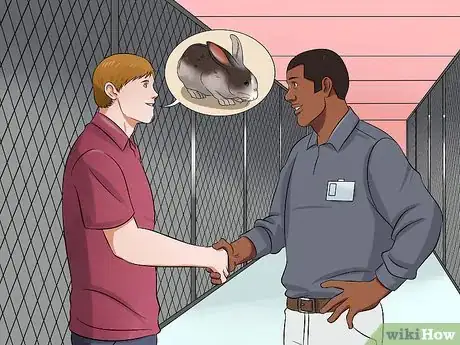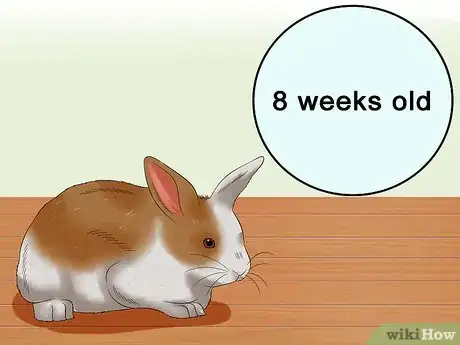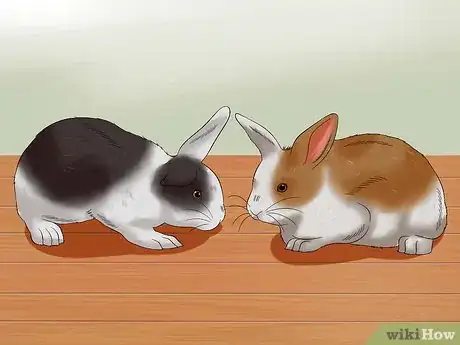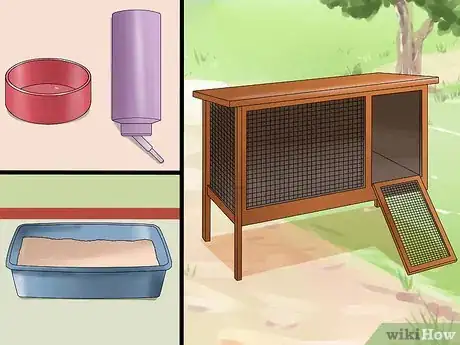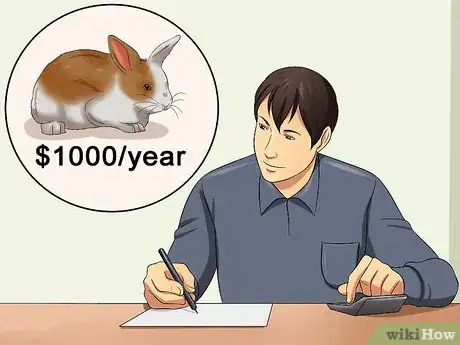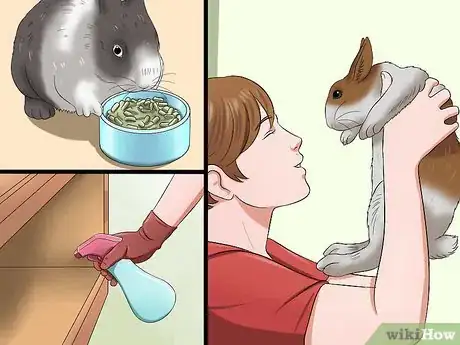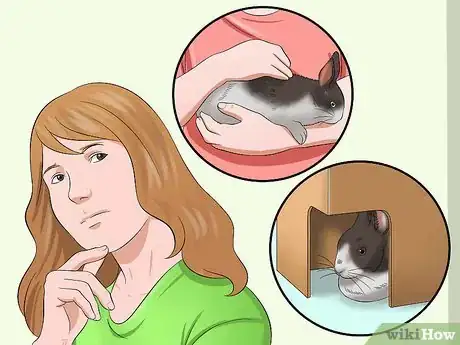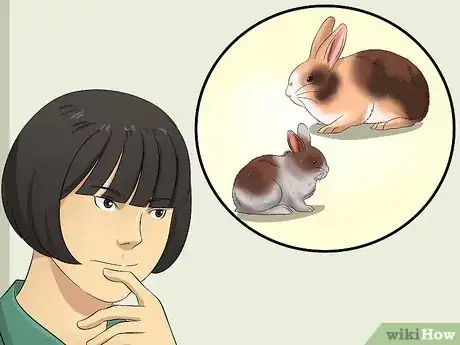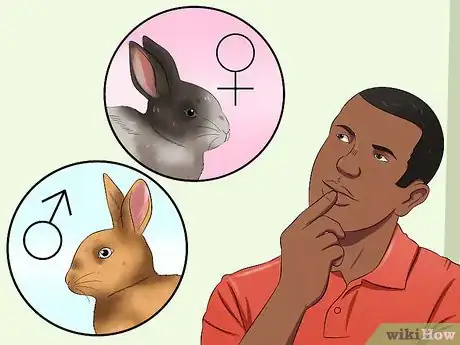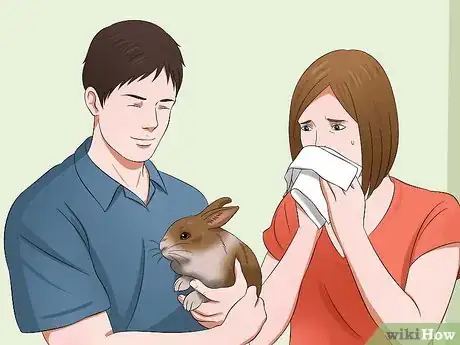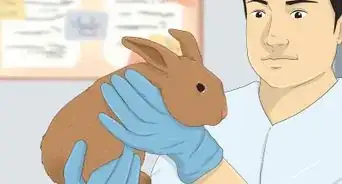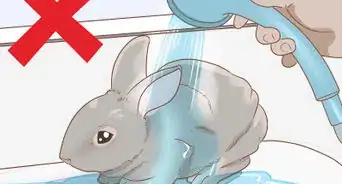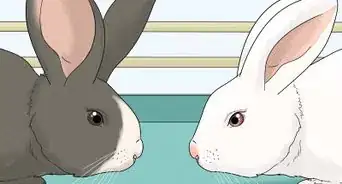This article was co-authored by Pippa Elliott, MRCVS. Dr. Elliott, BVMS, MRCVS is a veterinarian with over 30 years of experience in veterinary surgery and companion animal practice. She graduated from the University of Glasgow in 1987 with a degree in veterinary medicine and surgery. She has worked at the same animal clinic in her hometown for over 20 years.
There are 11 references cited in this article, which can be found at the bottom of the page.
wikiHow marks an article as reader-approved once it receives enough positive feedback. In this case, several readers have written to tell us that this article was helpful to them, earning it our reader-approved status.
This article has been viewed 194,738 times.
Rabbits are very cute animals, which can make them irresistible as pets. Even with their floppy ears, twitching noses, and cute faces, rabbits require a high level of care.[1] By taking the time to make a well-informed decision to buy and care for a rabbit, you will help your rabbit live a long and happy life.
Steps
Buying a Rabbit
-
1Do not buy your rabbit from a pet store. Rabbits in pet stores likely come from mass-breeding facilities,[2] which tend to be more focused on turning a profit than providing a healthy environment in which to breed and raise animals. In addition, young rabbits in pet stores may be especially prone to digestive problems,[3] given the stress of living in a pet store and the significant dietary changes.
- When you visit a pet store, ask the staff about where the animals come from. Reconsider buying a rabbit from a pet store if you cannot verify that the rabbits came from a reputable breeder, animal shelter, or rabbit rescue.
-
2Buy your rabbit through a local animal shelter or rescue group. Compared with the staff at a pet store, the staff at an animal shelter or rescue group is more likely to have in depth knowledge of rabbit care.[4] In addition, rabbits tend to be healthier and better socialized at an animal shelter or rescue group than a pet store.[5]
- Visit the shelter or rescue group before purchasing your rabbit. Ask questions about how the organization cares for its rabbits, how rabbits are determined to be adoptable, the process of adopting a rabbit, and what post-adoption care is available.[6]
- Animal shelters and rescue groups often partner together to find good homes for the rabbits in their care.[7]
- Visit the websites https://www.petfinder.com/ and http://rabbit.org/ (House Rabbit Society) if you are unsure about where to find animal shelters or rabbit rescue groups in your area.
- Also consider finding a rabbit through private rabbit adoption agencies.[8]
- Rabbits from shelters are usually cheaper than rabbits from pet shops or breeders, since they're usually desexed, vaccinated, wormed and microchipped, while most pet shop rabbits and many breeder rabbits are not. They might cost a bit more at the shelter, but in the long run it will be cheaper to buy them there, since desexing, microchipping, vaccinating and worming rabbits can cost you hundreds of dollars.
Advertisement -
3Buy a rabbit from a reputable rabbit breeder. Buying your rabbit from a rabbit breeder is another option. Be aware, though, that not all breeders provide the proper rabbit care or are even knowledgeable about proper breeding practices. Unfortunately, some breeders may simply be trying to make money on the side [9]
- To identify a reputable breeder, ask for recommendations from an exotic veterinarian or a trusted friend who owns rabbits. You can also visit rabbit shows to learn about rabbit breeders in your area [10]
- A good breeder should be motivated by a genuine love for what they do, not solely by profit. They should be happy to provide with information about rabbits. They should also check to see if their customers are capable of looking after rabbits.
- When you visit the breeder, take a close look at the breeding facility. It should be clean and well maintained, and the rabbits should be healthy and happy.[11]
- Ask the breeder about his or her breeding practices, and ask to see breeding and genetics records.[12]
- A reputable breeder should be able to provide you with references of others who have purchased rabbits from him or her. In addition, he or she should have a good relationship with an exotic veterinarian.[13]
- If you are interested in a particular breeder, make sure that he or she provides you with a written health guarantee. The breeder should give you time to read through and understand the guarantee before you purchase a rabbit.[14]
-
4Check the rabbit for signs of illness. Although a rabbit from a reputable animal shelter, rescue group, or breeder is likely to be healthy, it is still a good idea to check the rabbit for signs of illness. For example, if the rabbit has a runny nose or has trouble breathing, he may have a respiratory infection. If the rabbit is tilting his head, he may have an inner ear infection.[15]
- If you are not sure how to examine the rabbit, ask the breeder, animal shelter staff, or an exotic veterinarian to walk you through a physical exam of the rabbit. They can help you understand the signs of health and illness.
- If the rabbit appears ill, ask about how the rabbit would be treated, and if the rabbit would still be adoptable following treatment.
-
5Buy a rabbit when it is the proper age. A rabbit should not be bought until it is at least eight weeks old. By this age, the rabbit will be fully weaned from his mother and will be able to eat solid foods.[16] Wherever you buy your rabbit, make sure that they do not sell rabbits that are less than eight weeks old—this could be a sign of unethical breeding practices.
-
6Consider buying more than one rabbit. Rabbits are very social animals, and can get very lonely without a mate.[17] That being said, it is not quite as simple as buying two or more rabbits at a time. Rabbits can be very picky about their mates, [18] so you will need to put some thought into owning multiple rabbits.
- It is recommended to have male-female pairings, but same-sex pairings can work as well.[19] Two females should be fine, but two males will usually fight.
- Make sure the rabbits are neutered or spayed before putting them together. Intact rabbits can display aggressive behavior towards their mates, as well as develop a destructive chewing habit, due to sexual frustration.[20]
- It may be helpful to set up a time and neutral area for the two rabbits to meet. Animal shelters may have a separate room where rabbits can interact with each other. This would help you determine whether the pairing will work.[21]
-
7Purchase the initial supplies. Your rabbit will need a number of supplies in order to live a happy and healthy life at your home. For example, you will need a large, multi-level enclosure, which can be purchased at your local pet store.[22] In addition, you will need food dishes, a water bottle, a litter box with litter, and plenty of chew toys.[23]
- You will also need to purchase bedding (e.g., aspen chips, paper, straw) to line the bottom of the enclosure.[24]
- A litter scoop and disinfectant will be useful for cleaning your rabbit’s cage.[25]
- Your rabbit will also need a “nest” box in which he can sleep and rest.[26]
- In addition to purchasing fresh vegetables from the grocery store, you should also purchase fresh pellets and hay from the pet store to feed your rabbit.[27]
- The staff at your local pet store can give you additional assistance with purchasing all of the necessary supplies for your rabbit.
Deciding to Buy a Rabbit
-
1Calculate the costs of owning a rabbit. The initial and long-term costs of owning a rabbit can add up quickly. Initial costs are usually between $300 and $400, and long-term care may cost you about $1000/year—not including veterinary care.[28] Before you buy a rabbit, analyze your budget to determine if you can comfortably afford to care for one.
- Initial costs include housing, food dishes, electrical cord protectors (rabbits like to chew), a litter box, and toys.[29] [30]
- Ongoing costs include fresh vegetables, hay, and litter.[31]
- Incidental costs, such as veterinary care and furniture and toy replacement,[32] can increase the cost of care.
-
2Determine if you have enough time to own a rabbit. Having a pet rabbit can be time consuming. For example, you would need to feed your rabbit twice daily, tidy his cage once daily, and thoroughly clean his cage once a week.[33] [34] In addition, you would need to provide your rabbit with daily mental stimulation (e.g., chew toys, playtime).[35]
-
3Learn about rabbit temperaments. Just like other animals, rabbits can have different personalities and temperaments. Some may enjoy being held, and others may resist being held so much that they will injure themselves trying to escape.[39] Some rabbits may enjoy being petted,[40] and others may not care for much human interaction.
- Being aware of these temperaments, and others, may help you determine if having a pet rabbit is right for you.
- A rabbit’s personality is often influenced by how it has been socialized with people.[41]
- Rabbits may not be a good choice if you have young children, since young children may not understand that a rabbit does not necessarily like to be held and cuddled.[42]
-
4Decide what breed of rabbit you would like. There are nearly 50 rabbit breeds that are recognized in the United States.[43] It may seem like an arduous task to research all breeds, but it would certainly be time well spent. It is important to note that some breeds make good pets, and others are better suited for shows or breeding.[44]
- Popular pet rabbit breeds include the Lionhead rabbit, the English lop, and the Dutch rabbit.[45]
- The website https://www.arba.net/breeds.htm is an excellent source of information about the rabbit breeds that are recognized in the United States.
- Consider talking with rabbit owners, exotic veterinarians, or rabbit breeders for additional guidance on choosing a pet rabbit breed.
-
5Determine what age rabbit you would like. As cute as they are, baby rabbits like to chew on just about everything. The chewing action helps them strengthen their jaw muscles and learn about their environment,[46] but can mean destruction if you do not keep an eye on them. In addition, baby rabbits do not like to be held for very long,[47] which could lengthen the time it takes for the rabbit to bond with you.
- ‘Teenage’ rabbits (around three months old) are very energetic and can get bored easily.[48] If you want a teenage rabbit, make sure you have enough toys and extra time to keep him entertained.
- Adult rabbits, when spayed or neutered, are more amenable to being held. Adult rabbits are probably suitable if you have young children.[49]
-
6Decide whether you want a male or female rabbit. Females tend to be grumpy, and males tend to be aggressive, before being spayed or neutered.[50] Although the choice is yours, it may be less important to choose a sex than to ensure that the rabbit is spayed or neutered before you purchase it.
-
7Find out if anyone in your household is allergic to rabbits. People can be allergic to rabbits, or to the hay that rabbits eat.[51] An allergist will be able to determine if you or anyone in your home has a rabbit or hay allergy.[52]
- If an allergy is identified, consider finding another type of animal to own as a pet.
- One reason rabbits end up in shelters is because the owner, or a member of the owner’s household, is allergic to rabbits or hay.[53] Identifying these allergies beforehand can prevent the emotional hardship of having to give your rabbit to an animal shelter or rescue group.
Expert Q&A
Did you know you can get expert answers for this article?
Unlock expert answers by supporting wikiHow
-
QuestionWhat rabbits make the best pets?
 Melissa Nelson, DVM, PhDDr. Nelson is a Veterinarian who specializes in Companion and Large Animal Medicine in Minnesota, where she has over 18 years of experience as a veterinarian in a rural clinic. She received her Doctor of Veterinary Medicine from the University of Minnesota in 1998.
Melissa Nelson, DVM, PhDDr. Nelson is a Veterinarian who specializes in Companion and Large Animal Medicine in Minnesota, where she has over 18 years of experience as a veterinarian in a rural clinic. She received her Doctor of Veterinary Medicine from the University of Minnesota in 1998.
Veterinarian
-
QuestionWill the bunny get scared when I'm not home?
 Pippa Elliott, MRCVSDr. Elliott, BVMS, MRCVS is a veterinarian with over 30 years of experience in veterinary surgery and companion animal practice. She graduated from the University of Glasgow in 1987 with a degree in veterinary medicine and surgery. She has worked at the same animal clinic in her hometown for over 20 years.
Pippa Elliott, MRCVSDr. Elliott, BVMS, MRCVS is a veterinarian with over 30 years of experience in veterinary surgery and companion animal practice. She graduated from the University of Glasgow in 1987 with a degree in veterinary medicine and surgery. She has worked at the same animal clinic in her hometown for over 20 years.
Veterinarian Rabbits spend their time eating and sleeping. As long as the rabbit has a shelter to hide in, this is like a wild rabbit going down a burrow, and she is unlikely to be scared when you aren't there. However, rabbits can get bored, so make her hutch and run an interesting place for her to be by providing interactive toys and activities. Simple things, like hiding small amounts of food under upturned flower pots, can encourage foraging behavior and provide mental stimulation. Likewise, stuff cardboard tubes (such as toilet roll inner) with hay so the rabbit gets the double interest of chewing the cardboard to get to the hay. You could even try putting dry food in a puzzle feeder.
Rabbits spend their time eating and sleeping. As long as the rabbit has a shelter to hide in, this is like a wild rabbit going down a burrow, and she is unlikely to be scared when you aren't there. However, rabbits can get bored, so make her hutch and run an interesting place for her to be by providing interactive toys and activities. Simple things, like hiding small amounts of food under upturned flower pots, can encourage foraging behavior and provide mental stimulation. Likewise, stuff cardboard tubes (such as toilet roll inner) with hay so the rabbit gets the double interest of chewing the cardboard to get to the hay. You could even try putting dry food in a puzzle feeder. -
QuestionHow can I help my rabbit stop stressing out?
 Pippa Elliott, MRCVSDr. Elliott, BVMS, MRCVS is a veterinarian with over 30 years of experience in veterinary surgery and companion animal practice. She graduated from the University of Glasgow in 1987 with a degree in veterinary medicine and surgery. She has worked at the same animal clinic in her hometown for over 20 years.
Pippa Elliott, MRCVSDr. Elliott, BVMS, MRCVS is a veterinarian with over 30 years of experience in veterinary surgery and companion animal practice. She graduated from the University of Glasgow in 1987 with a degree in veterinary medicine and surgery. She has worked at the same animal clinic in her hometown for over 20 years.
Veterinarian Rabbits are prey animals, and stress is a default position if they feel anxious or unsafe. Key to reducing stress is to build their self-confidence and help them feel safe. Start with basics, such as siting the hutch in a quiet corner, well away from other pets and a noisy TV. Make sure the rabbit has a shelter where she can hide, and that part of the hutch is covered so she has a dark area to escape to when fearful. Rather than pick her up if she is frightened, gently encourage her to come to you with food treats. Be patient, because it could take weeks or months. Once she learns she's safe, then she'll stop stressing.
Rabbits are prey animals, and stress is a default position if they feel anxious or unsafe. Key to reducing stress is to build their self-confidence and help them feel safe. Start with basics, such as siting the hutch in a quiet corner, well away from other pets and a noisy TV. Make sure the rabbit has a shelter where she can hide, and that part of the hutch is covered so she has a dark area to escape to when fearful. Rather than pick her up if she is frightened, gently encourage her to come to you with food treats. Be patient, because it could take weeks or months. Once she learns she's safe, then she'll stop stressing.
Warnings
References
- ↑ https://www.care.com/a/so-you-want-to-adopt-a-rabbit-03071051
- ↑ http://www.humanesociety.org/animals/rabbits/tips/getting_a_rabbit.html
- ↑ http://www.rabbitmatters.com/buying-a-rabbit.html
- ↑ http://www.humanesociety.org/animals/rabbits/tips/getting_a_rabbit.html
- ↑ http://www.humanesociety.org/animals/rabbits/tips/getting_a_rabbit.html
- ↑ http://www.humanesociety.org/animals/rabbits/tips/getting_a_rabbit.html
- ↑ http://www.humanesociety.org/animals/rabbits/tips/getting_a_rabbit.html
- ↑ http://www.humanesociety.org/animals/rabbits/tips/getting_a_rabbit.html
- ↑ http://www.humanesociety.org/animals/rabbits/tips/getting_a_rabbit.html
- ↑ http://www.humanesociety.org/animals/rabbits/tips/getting_a_rabbit.html
- ↑ http://www.humanesociety.org/animals/rabbits/tips/getting_a_rabbit.html
- ↑ http://www.humanesociety.org/animals/rabbits/tips/getting_a_rabbit.html
- ↑ http://www.humanesociety.org/animals/rabbits/tips/getting_a_rabbit.html
- ↑ http://www.humanesociety.org/animals/rabbits/tips/getting_a_rabbit.html
- ↑ http://www.rabbit.org/care/sick.html
- ↑ http://www.rabbitmatters.com/buying-a-rabbit.html
- ↑ http://rabbit.org/thinking-of-adopting-a-rabbit/
- ↑ http://rabbit.org/thinking-of-adopting-a-rabbit/
- ↑ http://rabbit.org/thinking-of-adopting-a-rabbit/
- ↑ http://rabbit.org/thinking-of-adopting-a-rabbit/
- ↑ https://www.care.com/a/so-you-want-to-adopt-a-rabbit-03071051
- ↑ http://www.humanesociety.org/animals/rabbits/tips/rabbit_housing.html?credit=web_id125181255
- ↑ http://www.drsfostersmith.com/pic/article.cfm?articleid=133
- ↑ http://www.drsfostersmith.com/pic/article.cfm?articleid=133
- ↑ http://www.drsfostersmith.com/pic/article.cfm?articleid=133
- ↑ http://www.drsfostersmith.com/pic/article.cfm?articleid=133
- ↑ http://www.drsfostersmith.com/pic/article.cfm?articleid=133
- ↑ http://myhouserabbit.com/new-to-rabbits/how-much-does-a-pet-rabbit-cost/
- ↑ http://myhouserabbit.com/new-to-rabbits/how-much-does-a-pet-rabbit-cost/
- ↑ http://www.drsfostersmith.com/pic/article.cfm?articleid=133
- ↑ http://myhouserabbit.com/new-to-rabbits/how-much-does-a-pet-rabbit-cost/
- ↑ http://myhouserabbit.com/new-to-rabbits/how-much-does-a-pet-rabbit-cost/
- ↑ http://www.drsfostersmith.com/pic/article.cfm?articleid=133
- ↑ http://www.humanesociety.org/animals/rabbits/tips/rabbits_as_pets.html?credit=web_id125181255
- ↑ http://www.drsfostersmith.com/pic/article.cfm?articleid=133
- ↑ http://www.humanesociety.org/animals/rabbits/tips/rabbits_as_pets.html?credit=web_id125181255
- ↑ http://www.drsfostersmith.com/pic/article.cfm?articleid=133
- ↑ http://www.humanesociety.org/animals/rabbits/tips/rabbits_as_pets.html?credit=web_id125181255
- ↑ http://www.drsfostersmith.com/pic/article.cfm?articleid=133
- ↑ http://www.drsfostersmith.com/pic/article.cfm?articleid=133
- ↑ http://www.drsfostersmith.com/pic/article.cfm?articleid=133
- ↑ http://www.drsfostersmith.com/pic/article.cfm?articleid=133
- ↑ https://www.care.com/a/so-you-want-to-adopt-a-rabbit-03071051
- ↑ https://www.arba.net/breeds.htm
- ↑ http://mom.me/pets/small-pets/19118-popular-pet-rabbit-breeds/item/dutch-rabbit/
- ↑ http://rabbit.org/thinking-of-adopting-a-rabbit/
- ↑ http://rabbit.org/thinking-of-adopting-a-rabbit/
- ↑ http://rabbit.org/thinking-of-adopting-a-rabbit/
- ↑ http://rabbit.org/thinking-of-adopting-a-rabbit/
- ↑ http://rabbit.org/thinking-of-adopting-a-rabbit/
- ↑ http://rabbit.org/thinking-of-adopting-a-rabbit/
- ↑ http://rabbit.org/thinking-of-adopting-a-rabbit/
- ↑ http://rabbit.org/thinking-of-adopting-a-rabbit/
- ↑ http://www.humanesociety.org/animals/rabbits/tips/getting_a_rabbit.html
- ↑ http://www.humanesociety.org/animals/rabbits/tips/rabbits_as_pets.html?credit=web_id125181255
- ↑ http://www.drsfostersmith.com/pic/article.cfm?articleid=133
- ↑ http://www.rabbitmatters.com/buying-a-rabbit.html
- ↑ http://www.drsfostersmith.com/pic/article.cfm?articleid=133
- ↑ http://www.drsfostersmith.com/pic/article.cfm?articleid=133
- ↑ http://www.drsfostersmith.com/pic/article.cfm?articleid=133
About This Article
Before buying a rabbit, try visiting your local animal shelter and seeing if they have a rabbit you like, since animals from shelters tend to be healthier and better socialized than those from a pet store. Alternatively, use petfinder.com to search for a rabbit through a rescue organization. You can also ask your veterinarian for a recommendation for a reputable rabbit breeder, and contact them directly about buying a rabbit. Once you find a rabbit you like, make sure to examine it for signs of illness, like a runny nose or head tilting, before you bring it home. For advice from our Veterinary reviewer on how to prepare an enclosure for your new rabbit before you bring it home, keep reading.

